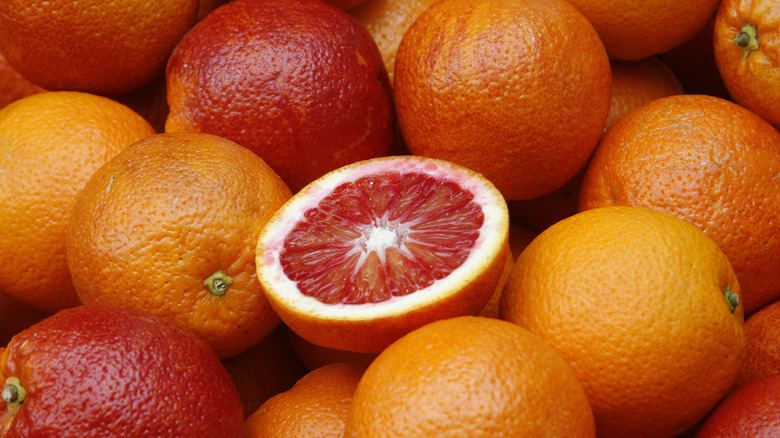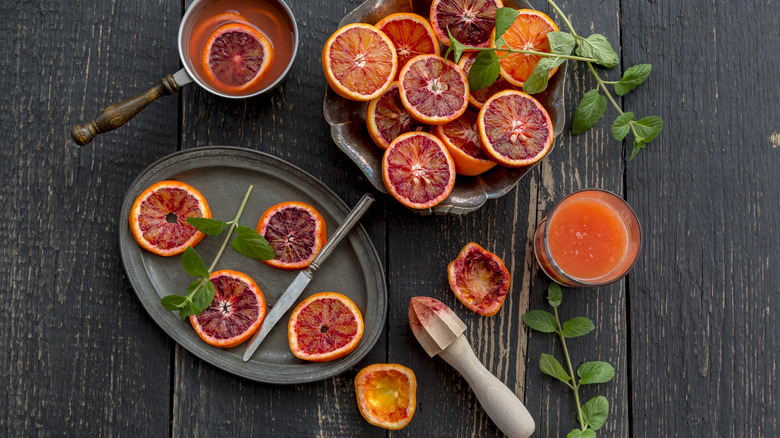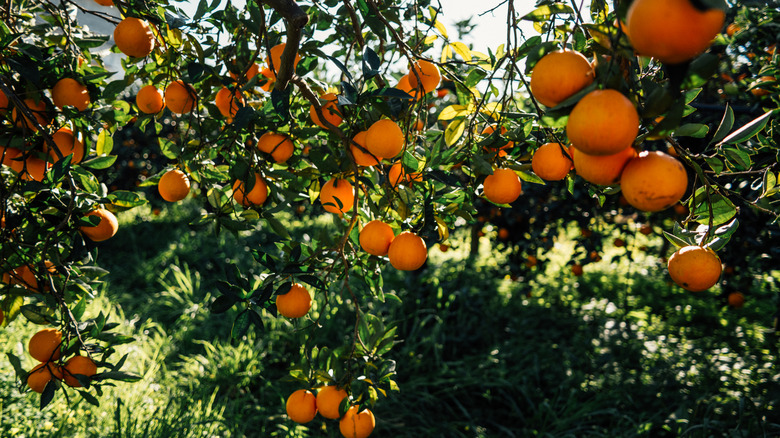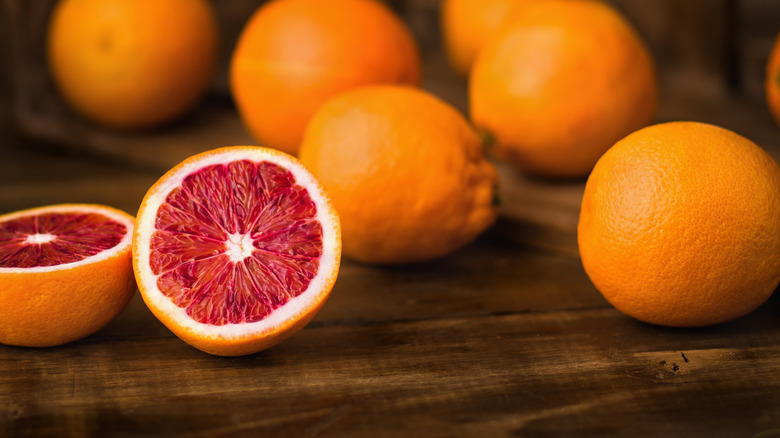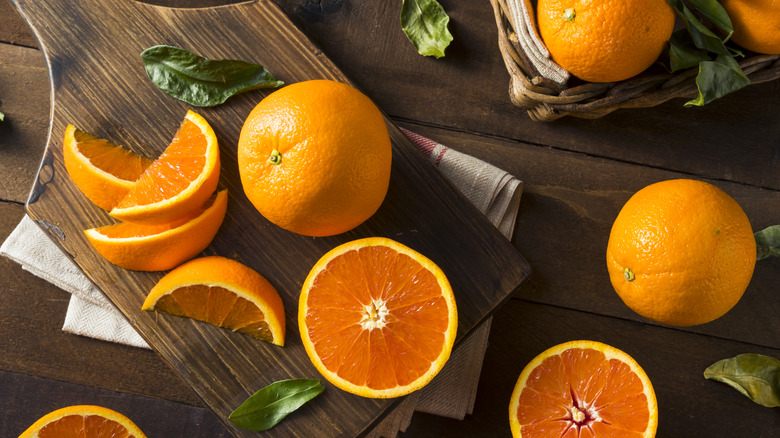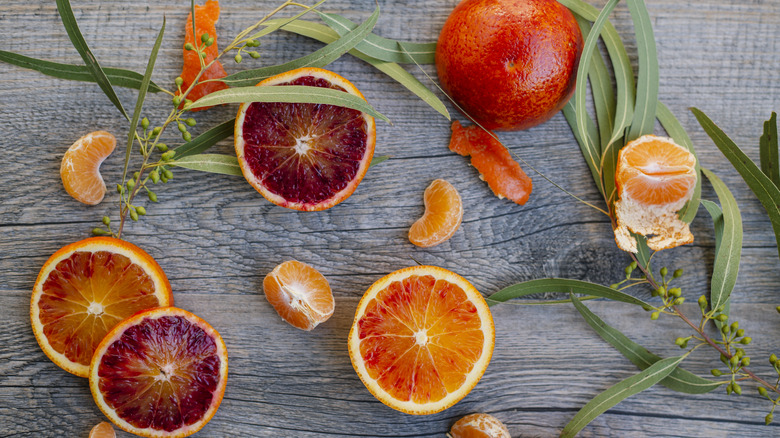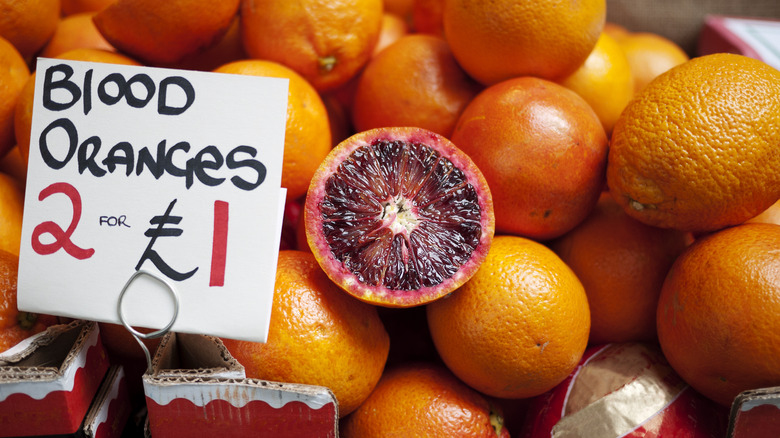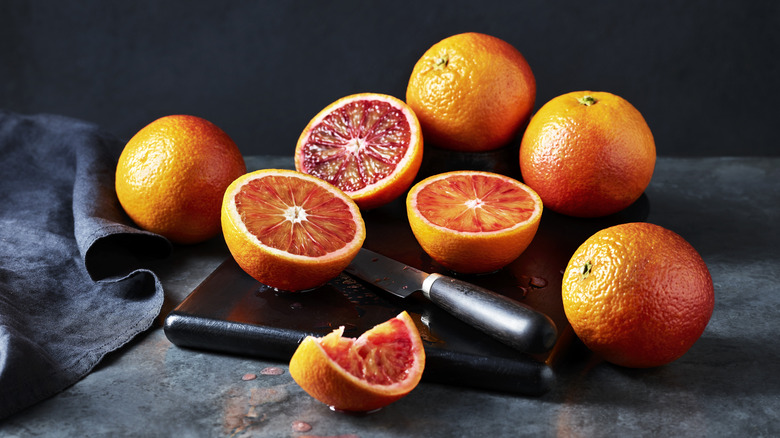What Is A Blood Orange? How To Buy, Use, And Store The Colorful Citrus
Blood oranges are the ultimate surprise fruit inside. They may look like a traditional orange on the surface, but inside, their vibrant, deep crimson flesh and sweet, tangy juice set them a world apart from a regular orange. Though, a blood orange looks as if it could be the baby of a regular orange and a grapefruit. They bring an exotic flair to both sweet and savory recipes, adding their vivid color and bright burst of flavor and nutrition to everything from tropical smoothies to pasta dishes, margarita cocktails, and chocolate desserts. They also make a delicious, nutritious snack.
Though you can easily purchase standard oranges year-round, grab blood oranges when you see them. They have a short growing season, which makes them an extra special treat. We're sharing everything you need to know to make blood oranges a regular part of your life in the kitchen, from their origins to their available varieties, along with tips for choosing and storing them.
What are blood oranges?
It's blood oranges' magnificent color that both sets them apart and gives them their name. If you're wondering where that color comes from and why blood oranges are red, it's all due to the presence of anthocyanins, a powerful antioxidant found in many fruits and vegetables. If a fruit or vegetable is red, blue, or purple in color, it's because of anthocyanins. In blood oranges, the anthocyanins cause the fruit to darken on and near the peel at first. It then creeps into the flesh, which explains why some have skin and flesh that are streaked instead of a solid red color.
Blood oranges hail back to ninth-century Sicily, where they were once a luxury food reserved only for nobility. Over time, their unique flavor and vibrant color gained widespread appreciation, which prompted Sicilian growers to export them beyond the region. Today, blood oranges are cultivated worldwide.
What do blood oranges taste like?
There's nothing like biting into a juicy orange segment or drinking a glass of freshly squeezed orange juice. If you want to stick with citrus but experience a new level of flavor, grab a blood orange. Whether you're snacking on its trademark ruby-red flesh or drinking its juice, blood oranges are a tasty alternative to the traditional oranges we're used to.
Blood oranges might look like standard oranges from the outside, but they have a unique flavor of their own. Yes, they taste similar to other oranges with a balance of sweet and tart, but they have their own distinctive taste that differentiates them from other types of oranges. Taste-wise, they are very close to navel oranges, but they are typically sweeter and slightly less astringent. They have a complex flavor with mild floral notes and hints of raspberry. The flavor will vary slightly depending on the variety of blood orange you choose, but there's no bad option, as each variety offers a delicious variation on an orange theme.
Where are blood oranges grown?
Blood oranges require a specific climate to grow and develop their trademark color. They are traditionally grown in the Mediterranean, where warm days and cold nights are common. The anthocyanins, which produce the darker flesh, require drastic changes in temperatures in order to thrive. If the nighttime temperature doesn't drop below freezing for at least an hour, the anthocyanins won't develop, and no true blood oranges will be produced.
Areas of Italy, Spain, Portugal, and Malta with temperate climates are the growing grounds of many blood oranges. In Sicily, where blood oranges are considered one of the area's most valued crops, the combination of the perfect climate and fertile soil near Mt. Etna creates the ideal growing conditions for blood oranges to flourish.
Blood oranges have become increasingly popular in the United States in recent years. They're produced in parts of Texas, Florida, California, and Arizona, where temperatures often mirror those found in the Mediterranean.
When are blood oranges in season?
Blood orange season is short, so it's important to grab them when you see them in your grocery store's produce section. Unlike a lot of fresh produce in season during the warmer months of the year, the unique climate blood oranges require gives them a late fall and winter harvesting season. Because they need cold temperatures to thrive, they are peak-perfect during the winter months and early spring.
If chilly, dark winter days have you longing for a taste of the tropics, reach for a blood orange. They're an excellent way to brighten up the frigid months. Blood orange season typically runs from December through May, depending on both the type of blood orange and where they're grown. For example, some of those grown in Sicily are in season from December through April.
Blood oranges vs. Cara Cara oranges
Blood oranges and Cara Cara oranges are often mistaken for each other. They both resemble navel oranges and have flesh that is more deeply colored than standard oranges, but there are a number of differences between the two. Cara Cara oranges were first discovered in Cara Cara, Venezuela, and are actually a variety of navel oranges with a thinner peel.
Cara Caras do have a different color flesh than most navel oranges, which is why many people mistake them for blood oranges. Blood oranges are known for their deep red flesh, but Cara Cara oranges' flesh can range from a pinkish salmon color to orange or coral. Cara Cara oranges' colorful flesh is not because of anthocyanins, like blood oranges. It's a carotenoid called lycopene that gives Cara Cara oranges their distinct color.
Flavor-wise, Cara Cara oranges are usually sweeter with a less acidic flavor than most oranges. One thing Cara Cara oranges have in common with blood oranges is a short season. Cara Caras are typically only available from December through April.
Varieties of blood oranges
If you made a list of the most popular types of oranges, blood oranges would surely land a spot at the top of the list. Short growing season and limited availability aside, blood oranges have evolved from relative obscurity to a shining star on the food scene. Blood oranges come in several varieties, each with its own coloring and flavor profile. Though there are over a dozen varieties of blood oranges, you're likely to find only three varieties — Moro, Sanguinello, and Tarocco — commonly grown and sold to consumers.
Moro blood oranges are the most popular variety in the United States. The rind is usually bumpy and tinged with red, and the flesh is deep red, almost purplish. Sanguinello blood oranges are native to Spain. They have an orange-yellow peel, typically with red blush, and the flesh is often streaked with deep red. Tarocco blood oranges, a favorite in Italy, are the largest variety and also the sweetest. You'll find red coloring on both the rind and the flesh.
How to choose and store blood oranges
When blood orange season rolls around, you want to make sure you choose the best fruit from the pile and that you store it properly so you can extend the deliciousness as long as possible. Blood oranges that are not fully ripe won't have the wonderful, full flavor we love. So, how are you supposed to know when blood oranges are at peak flavor when their thick rind hides the flesh inside? Much like picking out the perfect watermelon, there are certain things to look for when you're selecting a blood orange.
Look for blood oranges with firm skin. The rind on some varieties may be bumpy, but steer clear of oranges with a shriveled rind. The color of the rind is less important when choosing a blood orange since different varieties have rinds in various shades of orange or red. You can store your blood oranges at room temperature, where they should last for a couple of weeks. Storing them in the fridge will extend their shelf life. If you choose to refrigerate your blood oranges, place them in your crisper drawer.
Nutritional value of blood oranges
In addition to their striking good looks and delicious flavor, blood oranges are packed with nutritional benefits that make them a healthy food choice. The anthocyanins they contain not only give them their gorgeous color, but they're also a great antioxidant. Studies have shown that anthocyanins help fight inflammation and can even help prevent heart disease. Like other oranges, blood oranges are high in vitamin C. One blood orange contains 80% of the recommended daily value of vitamin C, which promotes immune health, cardiovascular disease, eye health, and skin vitality.
Blood oranges are also a good source of fiber. Each blood orange contains 3 grams of fiber, which does not cause blood sugar spikes like other carbohydrates. These are just a few of the benefits you can enjoy by incorporating blood oranges into your diet. Make the most of the season and fill your fruit basket with blood oranges today!
